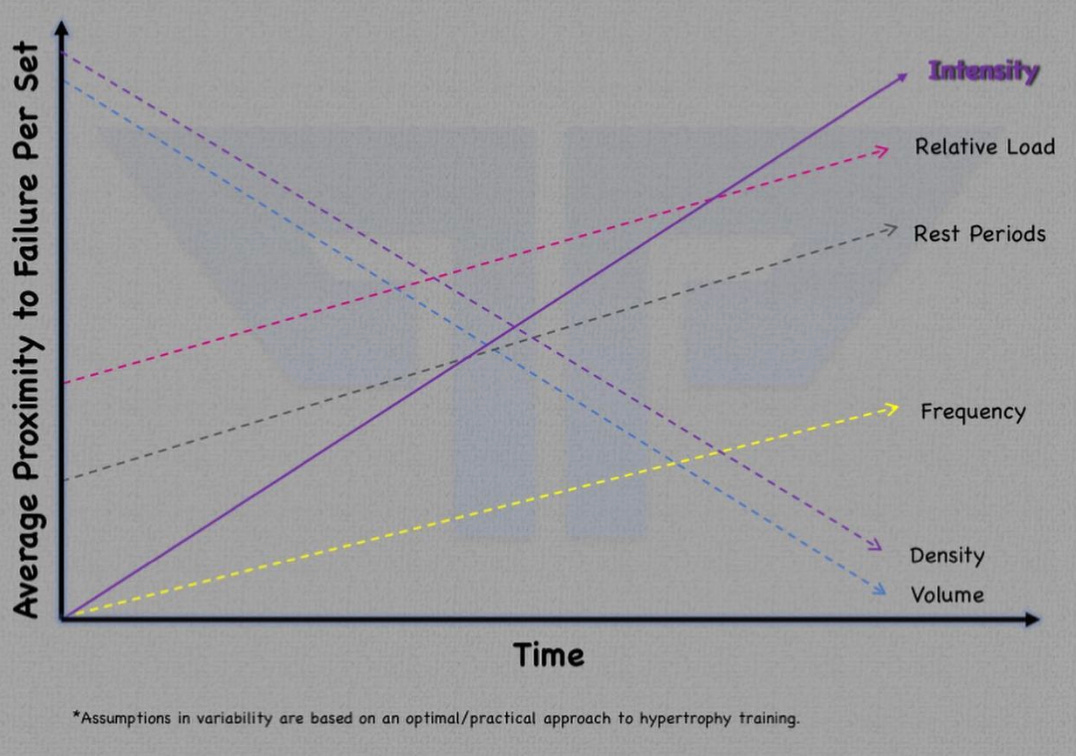A measure of how close to technical failure a set is taken.
We’re getting into the fun stuff now — linear changes in INTENSITY (average RIR per set).
- All set volume is performed on a single bodypart/lift versus divided up systemically (i.e. all sets inferred to be from leg extension/biceps curls/etc)
- Volume- 15 sets per week
- Density- 1:1 ratio with volume
- Frequency- 2x/wk
- Relative Load- 70% of 1RM
- Rest Periods- 3 min between sets
The effects discussed — and graphed — are going to be a function of an isolated comparison between our independent variable (here, intensity) and a dependent variable (we will evaluate them one at a time). The above parameters will act as standardization values when those variables are not being compared directly to volume.
Volume
As we have discussed, volume and intensity are inversely correlated. It’s extremely difficult to maintain high levels of effort with equally high volumes, but this effect can become even more pronounced as we start to shift the balance in favor of one or the other. With increasing intensity, the number of working sets MUST decrease, otherwise overreaching will occur quickly.
Density
In accordance with volume, the density of training must also decrease with rising intensity, provided we are maintaining consistent session durations.
Frequency
With increasing intensity comes the need to spread volume out over more sessions to prevent negatively impacting recovery too much from any single training day. If we are to consolidate a large amount of highly intense sets within 1 or 2 sessions per week, our timeline for recovery from that will be stretched too thin. On the other hand, distributing the volume over more sessions will allow for the average intensity to rise, while also better managing the cost of each working set. Obviously, this can’t continue indefinitely, but the premise remains within reasonable frequency ranges.
Relative Load
This one is tricky. When intensity is relatively low, we are essentially able to train at all levels of relative load unencumbered. But as it starts to increase over time (short or long term), we soon find that pushing sets close to failure with moderate loads (and higher reps) is actually MORE fatiguing than with higher relative loads. There is a lot more that goes into this variable tug-of-war, but up to a point, it is actually beneficial for weight on the bar to increase as intensity also increases.
Rest Periods
With sets closer to failure, it should be no surprise that rest periods will have to get longer. Depending on the individual and exercise being performed, the dose-response can vary greatly in absolute terms — but an increase in rest will always accompany an increase in intensity.
Though intensity is pretty well-known to be a driving force behind hypertrophy, it is often severely misunderstood when it comes to balancing and optimizing for muscle growth AND fatigue management.
Many coaches and trainees like to view intensity as a black-or-white concept — as in, you should always push to and beyond failure OR you should always leave a few reps in the tank. In reality, the answer lies somewhere in the middle. There are times when you can (and should) take sets to failure, but there are also times when staying more conservative is the best strategy.
How you choose to use intensity in your own training will be a product of personal predilections, as well as your own individual response. Whether you want to leave 4RIR or take every set to failure, understanding the ways in which everything else is affected by how hard you train will lead to more thoughtful decision-making and programming, rather than being guided by biases or rhetoric.

